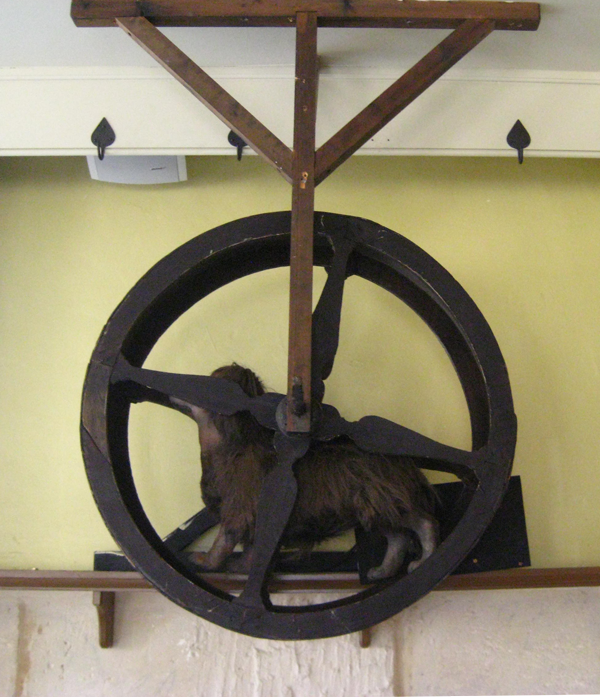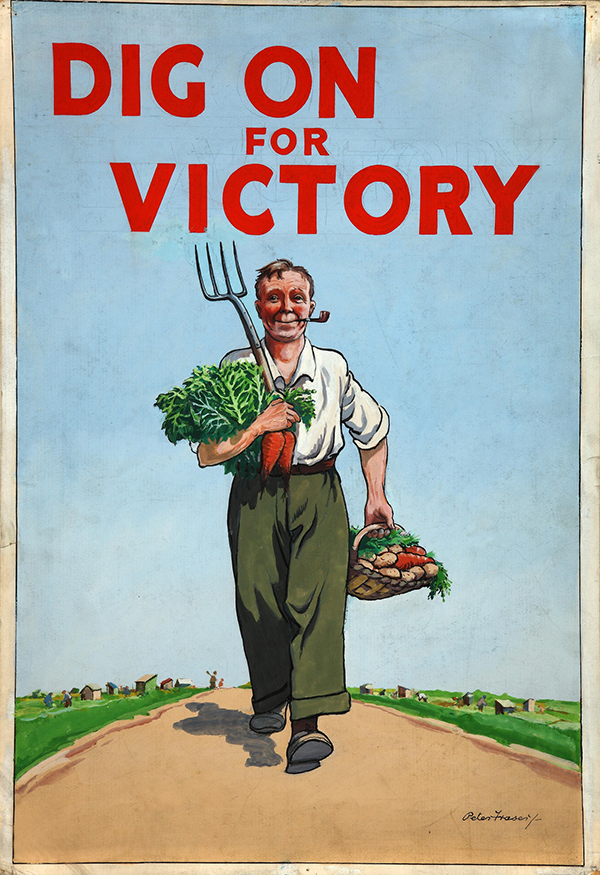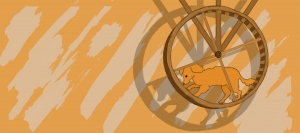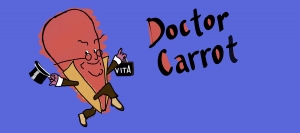#61 Turnspit Dogs
These days when you roast something, you’re most likely going to use an oven to get the job done, but it used to be that roasting was done over an open fire. Since an open fire meant that the heat source was only coming from one direction, you had to continuously turn the meat so that it would be cooked evenly on all sides, and not get burnt in one spot. So, before any automated way to turn a spit, someone had to do it by hand. Imagine you were that person. Imagine you were indoors with a blazing hot fire in front of you. Your eyes were watering from the smoke and fumes, and you were turning a heavy spit carrying over 30 pounds of meat on it. Imagine this was going to take several hours. Yikes, that sounds awful.
It was a rough job to do, so it was done by the lowest in the kitchen hierarchy. These were the scullions - usually boys - who worked in the kitchen doing all the cleaning. When the turnspit wheel was invented, and the horrible job of turning a spit could be passed on to animals, cooks quickly made the switch.

This is the incredible true story of Turnspit Dogs - a now extinct breed of dog that was used to turn roasting spits starting in the 1500s - the Tudor period in England. It was also known as "the vernapitur", which means "the dog that turns the wheel".
The earliest reference to turnspit dogs is in a book by Dr. John Caius which was published in 1570. Dr. John Caius was a physician (at one point, he was the physician at the court of Queen Elizabeth the 1st), and he was also a scientist who wrote about a lot of subjects. He wrote a book called "De Canibus Britannicis" that described all the breeds of dogs that he saw around him in the Britain of that time. He wrote it in Latin, but here's a translated excerpt: "they are in kitchen service excellent when any meat is to be roasted, they go into a wheel where they, turning about with the weight of their body, so diligently look to their business that not drudge nor scullion can do the feat more cunningly".
A Description of Turnspit Dogs

So here we should explain how these dogs were used to turn roasting spits. Basically, turnspit dogs were put into a wooden wheel that looked like a giant hamster wheel, and this wheel was hung over the roasting spit (as in hung over a large, blazing fire which was cooking delicious meat that they couldn’t have). They were forced to run in this wheel, which turned a chain, which turned the spit.
The turnspit dog was described as a kitchen service dog. They varied a lot in appearance, because they probably weren’t bred in any standardized way. Unlike today, dogs weren’t spayed or neutered back then, so if you had a couple of turnspit dogs, they probably would have taken care of their own breeding. They tended to have dark spotty fur, dropped ears, and their tails curled up high over their backs (this was important so that their tails wouldn’t get caught working in the wheels). The great naturalist, Thomas Bewick, described turnspit dogs as having odd-colored eyes in his 1790 book "A General History of Quadrupeds". They were also observed as having crooked legs, but it's unclear whether that was a trait of the breed, or because their legs were distorted from working in the wheel. In fact, Charles Darwin mentioned this as an example of nature vs. nurture in "On the Origin of the Species". Everyone described them as ugly, but from the few pictures we've seen, we would disagree.

Other than what people have written about them, we have some idea of what they looked like from various drawings. Also...there’s Whiskey.
Whiskey is the only (purported) stuffed turnspit dog in the world. You can find her at the Abergavenny Museum. She has quite a distorted shape - that could be because of a bad taxidermy job or it could be that she was deformed over the course of her life because of her work. Anyhow, notice the hump in her back. Whiskey doesn’t look like most of the descriptions of turnspit dogs, but, as we mentioned, they were a pretty varied breed. Turnspit dogs really just needed to be strong enough to do their gruelling task - they needed powerful little legs. Very little is known about Whiskey. She was given to the museum at Abergavenny and there was paper work associated with her at one point but that's gone missing. Because of the missing paperwork, we don't know how old she was, and we have to take the museum's word that she is in fact a turnspit dog. She is quite small and the museum also has the small wheel she is said to have worked in. There are about 8 wheels still in existence today and they vary in size. They go from about 75 to 145 cm in diameter, and from about 20 to 29 cm in width. So turnspit dogs of different sizes could have been used.
The Hard Life of a Turnspit Dog

The turnspit dog had an important but thankless job. The only way to make Britain's beloved roast beef was over an open spit, and dogs were cheaper than people. There was a lot of work for turnspit dogs to do. In large kitchens, there could be multiple different fires going in order to properly cook different types of meat. For a while, turnspit dogs were pretty well known - people saw them in may places. They were used in rich kitchens - in wealthy houses that would've been roasting meat every day. They were also seen in inns and hotels that had to cook large amounts of food for hungry travellers.
Turnspit dogs were a symbol of hard work reluctantly done. Pretty much all dogs at the time were working dogs, as the idea of pet ownership really emerged in the 1850s when hardly anyone was using turnspit dogs anymore, but even amongst the dogs of their time, they had some of the hardest lives. Their job was painful, and monotonous, and they really had no relationship with their masters. There are accounts that cooks would throw hot coals into the turnspit wheels to get the dogs’ feet moving faster. The job was so physically straining that sometimes dogs would be alternated, perhaps every few hours, or every second day. Some people believe that this is where the phrase “every dog has its day” comes from - referring to the days when turnspit dogs get to rest. It’s also said that turnspit dogs may have gotten some rest on Sundays. There were accounts of them being given half days to go to church to keep people's feet warm - that was something that a lot of small dogs did as a job at that period. From high status dog, like toy spaniels that were kept by fine ladies, down to lowly turnspit dogs. There were jokes about turnspit dogs running from the church when they heard the bishop talking about "roasting" or "hellfire", fearing that they were going to be put to work. Yeah, we don't think that's funny either - it's just sad.
The Extinction of the Turnspit Dog
![Roasting jack [from Mechanick Exercises] Roasting jack [from Mechanick Exercises]](/images/Episode_images/roastingjack.png)
Eventually, the inventiveness that created the cruel turnspit wheel also made it obsolete. Because roast meats were so important to British cuisine, people were always trying to make the cooking process easier. Mechanical jacks made turnspit dogs obsolete in most of England by the 1850s. It was only in the further reaches of England, for example Bristol and Somerset, that turnspit dogs were used into the 1860s, only because the mechanical jack may have taken longer to reach those areas. The earliest type of mechanical jack powered the turning of roasting spits by using a weight, which hung from a cord, which was wound up around a cylinder. As the weight slowly dropped, this moved a series of wheels and pulleys.
Over time, people experimented with many ways to power mechanical jacks, including steam, smoke, water, and clockwork. But we should note that the mechanics were not so new - Leonardo Da Vinci had drawn a sketch of a smoke-powered jack in his notebook around the year 1500 - but to the general public, this was high tech stuff at the time. We can't help but think that if this machine had been connected to a spit and made commercially available, it could have spared the lives of many dogs.
Anyhow, the turnspit dogs were mostly gone by the 1850s, barely hanging on in the 1860s and completely extinct by 1900. As an unloved breed with only one job to do, they quietly went extinct once that job was given away. But, while they are extinct, there are modern breeds that are possibly related to them. Some people say that they are related to French Basset Hounds or Dachshunds or Corgis. Likely candidates are rougher breeds of terriers, such as Glen of Imaal Terriers, which have very long bodies and strong little legs.
The end of the days of the turnspit dog was also the beginning of animal welfare associations. The founder of the ASPCA (The American Society for the Prevention of Cruelty to Animals) had seen the cruelty against turnspit dogs, so they would have been one of the many examples of cruelty that fueled the fight for animal welfare.
So, next time you make a roast - take a moment to remember the turnspit dog.
Special Thanks to Our Interviewee:
Ciara Farrell from The Kennel Club
#60 The Carrot Myth
Have you ever heard the carrot myth? You know, it's something that parents always tell their kids - that eating carrots will give you super night vision. Some people's parents really play this up - I used to think that eating carrots would give me cat-like vision, but that never got tested, because I didn't eat them anyways.
Where did the carrot myth come from? To answer the question, we spoke to Maya Hirschman - the manager and curator of the Secrets of Radar Museum.

Some researchers believe that the carrot myth started as a cover up for British radar technology. While radar technology was being developed before the Second World War, it became exceptionally important during the Second World War. Radar technology was being developed at such a rapid pace during WWII that any new breakthroughs had to be kept secret. Each new advancement could put you ahead of the competition. Radar was used both offensively (to guide attacks) and defensively (to detect attacks).
The British Royal Air Force developed the Airborne Interception Radar (AI). AI was used on aircraft for air-to-air combat. The German airforce (the Luftwaffe), often attacked at night and AI gave the British Royal Airforce superior night vision. One pilot was particularly good at using radar to take down German planes in the dark of night - his name was John Cunningham, and he was nicknamed “John Cat’s Eyes Cunningham”. In order to steer German suspicion away from the new technology, Cat’s Eyes’ abilities were attributed to him eating a lot of carrots.
People working with radar had to keep quiet and let carrots take the credit for their work. In Commonwealth countries, the official secrets act had a minimum period of 33 years - the radar personnel were under the Official Secrets Act for 50 years.
Why Attribute Cat's Eyes' Abilities to Carrots?

At the start of the Second World War, Britain was importing more than 50% of their food, which means that they could only produce less than half of their food needs if they were cut off of imported food supplies. Lord Woolton, who was the minister of food at the time, said that the Second World War was a "food war" - only if Britain could sustain their food supplies could they help to win the war. So, along with rationing, The U.K. Ministry of Food launched the Dig for Victory campaign. The idea of the campaign was to get people to turn their gardens into little vegetable farms to grow their own food in. Not only would this replace the loss of imported foods, some of it sunk by the German navy during transportation, less importing would also free up the merchant ships for war use - for example, for transporting troops and weapons. By the way, the United States Department of Agriculture also encouraged Americans to grow produce in their gardens - they called them “Victory Gardens”.
Dig for Victory slogan:
“Dig! Dig! Dig! And your muscles will grow big
Keep on pushing the spade
Don’t mind the worms
Just ignore their squirms
And when your back aches laugh with glee
And keep on diggin’
Till we give our foes a wiggin’
Dig! Dig! Dig! to Victory"
It was a successful campaign - by 1943 there were over a million vegetable gardens. People planted things like carrots, potatoes, and cabbages. One vegetable that was more plentiful was the carrot. So the ministry of food wanted people to start using more carrots in meals. But it wasn’t a popular vegetable at the time. In order to promote carrots, the Ministry of Food introduced Dr. Carrot as a carrot mascot. Lord Woolton, who, as we’ve mentioned was the Minister of Food, asked Disney to help create more carrot characters. Disney obliged and created a carrot family, including Carroty George, Clara Carrot, and Pop Carrot. (According to the World Carrot Museum, Disney offered one more character called Dr. Carrot, but as we mentioned, the Ministry of Food already had a character named Dr. Carrot.)
Leaflets with these carrot mascots alongside recipes for using carrots were distributed. The campaign for carrots generated tons of creative carrot recipes - like carrot fudge, curried carrot, and carrot pudding. The Ministry of Food also used a BBC radio program called The Kitchen Front to share all kinds of rationing tips and recipe suggestions. One episode gave the recipe for carrot curry, which actually sounded pretty good to me.
If you want to hear about the many stories from WWII radar veterans, then visit secretsofradar.com, and if you’re in London, Ontario then go and visit the museum! The museum was created by radar veterans to finally share their stories after 50 years under the Official Secrets Act. The history of WWII written during the 50 year period is missing the stories of the many radar personnel from the Commonwealth countries.
Food buffs, we should note that carrots are great for you. Carrots contain beta carotene, which the body converts to Vitamin A, which is important for eye health. Your parents gave you great advice. It can’t hurt to eat more carrots, but if you are already a regular person, eating decently balanced meals, with no vitamin deficiencies, then don’t expect the extra carrots to make much of a difference. As in don’t be expecting super-human night vision.
And while we’re on the topic of WWII in Britain, we feel like we should also mention the Women’s Land Army. The Women’s Land Army was established to get women to work on farms, helping to fight food shortage. These women worked the fields and managed the livestock. And members were referred to as “land girls”.
We found lyrics to two songs referred to as Land Girl’s Songs.
First, from a BBC article:
“Back to the Land, we must all lend a hand,
To the farms and the fields we must go,
There’s a job to be done,
Though we can’t fire a gun,
We can still do our bit with the hoe.”
And from a website called womenslandarmy.co.uk:
“I’m milking - at last I can actually milk
It took me some time, but I stuck it
So now I milk Buttercup, Daisy and Jane
And I really get froth on the bucket!
I think by next week I shall even milk four
My word, we are winning the war!”
Special Thanks to:
Maya Hirschman from The Secrets of Radar Museum for the interview
Public Service Broadcasting for allowing us to use their Dig for Victory track


